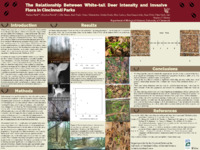The Relationship Between White-Tail Deer Intensity and Invasive Flora in Cincinnati Parks
Main Article Content
Abstract
By Nathan Pack, Biological Sciences - Ecology & Evolution; Hayden Pittock, Biology; Lillian Braun, University of Cincinnati; Grace Edmonston, University of Cincinnati; Jack Fogle, University of Cincinnati; Jordan Gerda, University of Cincinnati; Max Lackey, University of Cincinnati; Sara Langworthy, University of Cincinnati; Sean Pettit, University of Cincinnati
Advisor: Stephen Matter
Award: Excellence in Research Communication
Presentation ID: 210
Abstract: Urban deer populations have drastically increased over the past couple of decades, causing both economic and ecological problems. There have been many efforts and approaches to manage deer populations to achieve and maintain healthy population sizes. With regard to the Cincinnati parks, a select handful have implemented regulated bow hunting to try and bring populations to healthy levels; however, the success of this method is still unclear and there are various factors that need to be considered when trying to create a comprehensive management plan. One such factor pertains to the ecological aspects and how the presence or absence of a resource could potentially influence the intensity of deer within the parks of interest. We set out to calculate how the composition of the vegetation matrix with regard to the presence of invasive flora relates to deer intensities within the parks. Trail cameras were randomly placed within parks and the average number of bursts per hour was quantified. Vegetation transects were randomly conducted within the desired parks to obtain the vegetation data. We coupled the average number of bursts data with the mean abundance and species richness of the invasives from our vegetation data. Our data analysis consisted of running regressions to show potential relationships. The relationships could be helpful for management purposes when attempting to consider all the different factors associated with managing urban deer populations. Future studies regarding deer management could provide insight on how managing deer has impacted any ecosystem processes in any measurable way.
